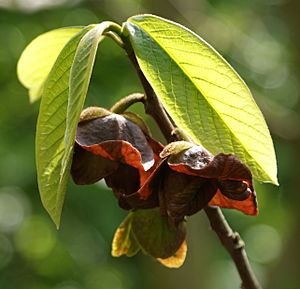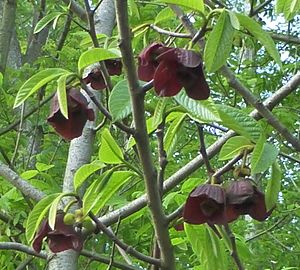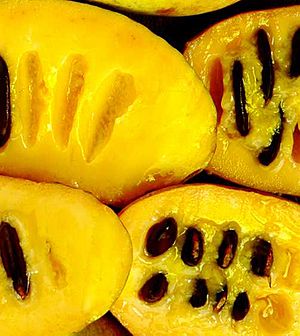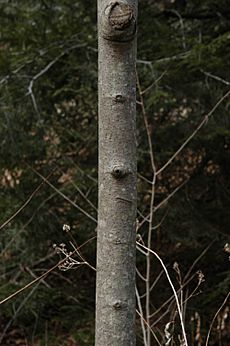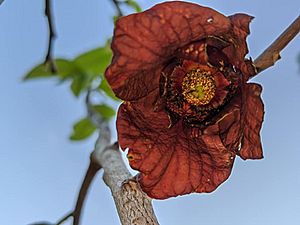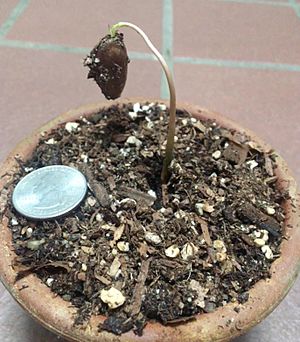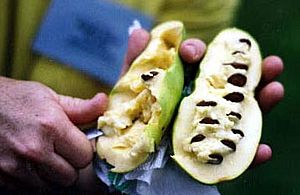American papaw facts for kids
Quick facts for kids American papaw |
|
|---|---|
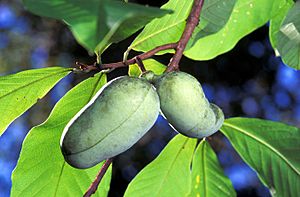 |
|
| Asimina triloba in fruit | |
| Conservation status | |
| Scientific classification | |
| Genus: |
Asimina
|
| Species: |
triloba
|
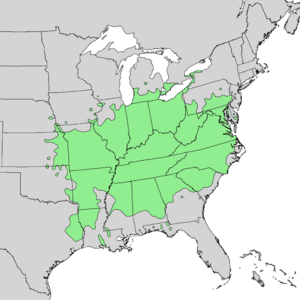 |
|
| Natural range of Asimina triloba | |
The pawpaw (scientific name: Asimina triloba) is a small tree that loses its leaves every year (deciduous). It grows naturally in the eastern parts of the United States and Canada. This tree is special because it produces a large, tasty fruit that changes from yellowish-green to brown when ripe.
The pawpaw belongs to the same plant family as other well-known fruits like the custard-apple, cherimoya, and sweetsop. It's known for forming patches or groups of trees, often growing under taller trees in forests. The pawpaw fruit is the largest edible fruit that grows naturally in the United States.
Pawpaw fruits have a sweet, creamy taste that reminds people of bananas, mangoes, and pineapples. People often eat them fresh, but they are also used to make delicious ice cream and baked treats. Some parts of the pawpaw plant, like the bark and leaves, contain natural chemicals that protect the plant from insects.
Contents
What's in a Name?
The scientific name for this tree is Asimina triloba. The name Asimina comes from a Native American word, probably from the Miami-Illinois language, meaning "assimin" or "rassimin." The second part of the name, triloba, describes the flowers. It means "three-lobed," referring to the three-lobed parts of the flower that look a bit like a tricorne hat.
The common name "pawpaw" is spelled in a few ways: pawpaw, paw paw, or papaw. It likely comes from the Spanish word papaya. This is because the pawpaw fruit looks a little like the tropical papaya fruit, which is also sometimes called "papaw." English speakers first used the name "pawpaw" for the tropical papaya in 1598. Later, when they found the Asimina triloba tree in North America, its sweet, aromatic fruit reminded them of the papaya, so they started calling it "pawpaw" too.
Many local names for the pawpaw compare it to a banana. Some of these names include:
- Wild banana
- Prairie banana
- Indiana banana
- Poor man's banana
- Hillbilly mango
Native American tribes also have their own names for the pawpaw, such as riwahárikstikuc (Pawnee) and umbi (Choctaw).
About the Pawpaw Tree
The pawpaw tree is usually a large shrub or a small tree. It can grow up to 35 feet (11 meters) tall, and sometimes even 45 feet (14 meters). Its trunk can be 8 to 12 inches (20 to 30 cm) wide. The tree has large leaves that are grouped together at the ends of its branches. This gives the tree a unique, layered look.
Leaves and Flowers
The leaves are simple, meaning they are not divided into smaller leaflets. They are arranged in a spiral pattern around the stem. Each leaf is about 10 to 12 inches (25 to 30 cm) long and 4 to 5 inches (10 to 13 cm) wide. When you crush the leaves, they have a smell that some people find unpleasant, like a green bell pepper. In the fall, the leaves turn a beautiful rusty yellow color. This makes pawpaw groves easy to spot from far away.
Pawpaw flowers are about 1 to 2 inches (2.5 to 5 cm) wide. They are a rich red-purple or maroon color when they are fully grown. These flowers appear in early spring, around the same time or just before the new leaves start to grow. They have a faint smell, sometimes described as yeasty or like rotting meat, which helps attract insects to pollinate them.
The Fruit
The pawpaw fruit is a large berry. It can be 2 to 6 inches (5 to 15 cm) long and 1 to 3 inches (2.5 to 7.5 cm) wide. Each fruit weighs between 0.7 and 18 ounces (20 to 510 grams). Inside the soft, edible pulp, there are several brown or black seeds. These seeds are about 1/2 to 1 inch (13 to 25 mm) in diameter. The fruits start out green and turn yellow or brown by September or October when they are ripe. When the fruits are mature, they are heavy and can make the branches bend down.
Other Features
- Bark: The bark is light gray and can have lighter spots. It's tough and fibrous.
- Wood: The wood is pale, greenish-yellow, and soft.
- Winter buds: There are two kinds of buds in winter: pointed ones for leaves and round, fuzzy ones for flowers.
Where Pawpaws Grow
The pawpaw tree grows naturally in the eastern, southern, and midwestern United States. Its range extends from New York west to southeastern Nebraska, and south to northern Florida and eastern Texas. It also grows in parts of southern Ontario, Canada.
Pawpaws often grow in floodplains and rich, shady areas near rivers. They tend to form dense patches or thickets of small, slender trees. This happens because they spread mostly by sending out root suckers, which are new shoots that grow from the roots of the main tree. They can also grow from seeds, but this happens less often.
Pollination
Pawpaw flowers are pollinated by insects. However, sometimes not many fruits are produced because the flowers don't attract many pollinators. The flowers produce a faint smell, sometimes like rotting meat, to attract blowflies and carrion beetles. These insects help move pollen from one flower to another. Pawpaw plants often need pollen from a different tree (a different genetic type) to produce fruit.
Animals and Insects
Many mammals enjoy eating pawpaw fruits, including raccoons, gray foxes, opossums, squirrels, and black bears.
The leaves, twigs, and bark of pawpaw trees contain natural chemicals called acetogenins. These chemicals act like natural insecticides. Because of this, rabbits, deer, goats, and most insects usually avoid eating pawpaw leaves and twigs.
However, the larvae (caterpillars) of the zebra swallowtail butterfly (Protographium marcellus) are special. They feed only on the young leaves of pawpaw trees. The chemicals from the pawpaw leaves stay in the butterflies' bodies, making them taste bad to birds and other predators. This helps protect the butterflies throughout their lives.
Conservation Status
Globally, the pawpaw is considered "very common." In the United States, it's also generally very common. However, it is listed as a threatened species in New York and an endangered species in New Jersey. In Canada, where it only grows in southern Ontario, it is considered "vulnerable." The Ontario Ministry of Natural Resources keeps an eye on its populations there.
In areas where there are many white-tailed deer, pawpaws seem to be growing more common. This is because deer avoid eating pawpaws, but they eat the seedlings of most other woody plants.
Pawpaw History
Before the last ice age, and up until about 10,000 years ago, large animals called megafauna helped spread pawpaw seeds across North America. After these animals died out, humans likely became the main way pawpaw seeds were spread.
The first time pawpaws were written about was in 1541. The Spanish explorer Hernando de Soto reported that Native Americans east of the Mississippi River were growing pawpaws. Later, the Lewis and Clark Expedition ate pawpaws during their travels. Thomas Jefferson even planted pawpaw trees at his home, Monticello, in Virginia. There's also a story that chilled pawpaw fruit was a favorite dessert of George Washington.
Pawpaw Research and Growing
Kentucky State University (KSU) has the only full-time pawpaw research program in the world. It started in 1990 to help make pawpaw a new fruit crop for Kentucky. Pawpaw is the largest native fruit in North America and has very few diseases compared to other fruit trees. KSU has a large collection of pawpaw trees and studies how to grow them better, how to store the fruit, and how to manage orchards.
Pawpaw trees grow best in hardiness zones 5-9. It takes about 7 to 8 years for a tree to start producing fruit from a seedling. KSU has even created new types of pawpaws called KSU-'Atwood', KSU-'Benson', and KSU-'Chappell'. These types focus on better flavors, more fruit, stronger plants, and less seeds in the fruit.
Growing Pawpaws
When growing pawpaws, the biggest challenge is often getting enough pollination for the trees to produce fruit. It's best to have at least two different types of pawpaw trees growing near each other for good cross-pollination. Growers sometimes help by hand-pollinating the flowers or by hanging things like chicken necks near the flowers to attract insects that will pollinate them. Even though zebra swallowtail caterpillars eat pawpaw leaves, they usually don't cause much harm to the trees.
Pawpaw fruits ripen quickly after they are picked. They can only be kept for 2-3 days at room temperature or about a week in the refrigerator. Because they bruise easily, pawpaws don't ship well unless they are frozen. People often use pawpaw pulp in baked recipes, like a substitute for bananas, or blend it into ice cream and pancakes.
Growing pawpaws for fruit has become popular, especially among organic growers. This is because the trees have few pests and can be grown without pesticides in their natural environment. Commercial pawpaw growing is strong in southeastern Ohio and is also being explored in Kentucky and Maryland. People are also growing pawpaws outside their native range, like in California and Massachusetts. Pawpaws are also becoming popular for landscaping and backyard gardeners because of their unique look, tasty fruit, and easy care once established.
How to Grow New Pawpaw Trees
It's easy to grow pawpaw trees from seeds. You can plant a whole fruit in the ground or just a seed right after you eat the fruit. It's important not to let the seeds dry out, as they won't grow if they get too dry. The seeds also need to be kept cold and moist for 60-100 days before they will sprout. They won't grow if stored for more than 3 years.
Growing new trees from cuttings (pieces of branches) usually doesn't work well.
If you want a specific type of pawpaw (a "cultivar"), you need to use a method called grafting. This is where a part of a desired tree is joined onto the root system of another tree. This is because seeds from a pawpaw fruit won't grow into a tree exactly like the parent tree.
Uses of Pawpaw
| Nutritional value per 100 g (3.5 oz) | |
|---|---|
|
18.8 g
|
|
| Dietary fiber | 2.6 g |
|
1.2 g
|
|
|
Protein
|
1.2 g
|
| Vitamins | Quantity
%DV†
|
| Vitamin A equiv. |
11%
87 μg |
| Thiamine (B1) |
1%
0.01 mg |
| Riboflavin (B2) |
8%
0.09 mg |
| Niacin (B3) |
7%
1.1 mg |
| Vitamin C |
22%
18.3 mg |
| Minerals | Quantity
%DV†
|
| Calcium |
6%
63 mg |
| Iron |
54%
7 mg |
| Magnesium |
32%
113 mg |
| Manganese |
124%
2.6 mg |
| Phosphorus |
7%
47 mg |
| Potassium |
12%
345 mg |
| Zinc |
9%
0.9 mg |
|
Analysis from Kentucky State University Pawpaw Program
|
|
| †Percentages estimated using US recommendations for adults. | |
Delicious Fruits
The pawpaw fruit looks a bit like a mango. It has pale yellow, creamy flesh that you can scoop out with a spoon, and black seeds that are easy to remove. Wild pawpaw fruits ripen in late August to mid-September. They have been a favorite treat for a long time in eastern North America. Sometimes, you can find them sold at local farmers' markets.
Pawpaw fruits have a sweet, creamy taste, often compared to bananas, mangoes, and cantaloupes. The taste can vary a lot depending on the tree or type. Pawpaws also have more protein than most fruits.
People usually eat fresh pawpaw fruits raw, either chilled or at room temperature. As mentioned, they don't last long, so they are often used in baked desserts. You can substitute pawpaw pulp for bananas in many recipes. Pawpaws are also great in ice cream or pancakes.
Nutrition Facts
According to Kentucky State University, raw pawpaw fruit (with skin) is mostly water (79%). It contains 19% carbohydrates, 1% protein, and 1% fat. A 100-gram serving of raw pawpaw provides 80 Calories. It's a great source of important nutrients like vitamin C, magnesium, iron, and manganese. It also has a good amount of vitamin A.
Natural Chemicals
The leaves, twigs, and bark of pawpaw trees contain natural chemicals called acetogenins. These chemicals are what make the pawpaw plant resistant to most insects. The seeds and bark also contain other similar chemicals.
The zebra swallowtail butterfly is unique because its caterpillars can eat pawpaw leaves. These caterpillars are not harmed by the chemicals. In fact, the chemicals stay in the butterflies' bodies, making them taste bad to birds and other animals that might try to eat them. This gives the butterflies a natural defense!
Historical Uses
In the past, Native Americans and early settlers in the Midwest used the tough, fibrous inner bark of the pawpaw tree. They made ropes, fishing nets, and mats from it. Pawpaw logs were even used to build split-rail fences in Arkansas. The hard, shiny brown seeds, which look like lima beans, were sometimes carried as good luck charms in Ohio.
Pawpaw in Culture
Old Song
There's a traditional American folk song about gathering pawpaws. Here are some of the lyrics:
Where, oh where is dear little Nellie?
Where, oh where is dear little Nellie?
Where, oh where is dear little Nellie?
Way down yonder in the pawpaw patch
Pickin' up pawpaws, puttin' 'em in your pocket
Pickin' up pawpaws, puttin' 'em in your pocket
Pickin' up pawpaws, puttin' 'em in your pocket
Way down yonder in the pawpaw patch
The song talks about "picking up pawpaws," which means gathering the ripe fruit that has fallen from the trees. The "pocket" mentioned in the song refers to an old-fashioned apron pocket, not a modern pants pocket, because pawpaws are quite large! A "pawpaw patch" is a group of pawpaw trees growing together.
Place Names
Many places and schools in the United States are named after the pawpaw, usually using the older spelling "paw paw."
- The Paw Paw Tunnel in Maryland is a long canal tunnel named after the pawpaw trees in the area.
- In Michigan, the Paw Paw River and Paw Paw Lake are named for the pawpaw trees that grew along their banks. The town of Paw Paw, Michigan, is also named after the tree.
- The village of Paw Paw, Illinois, was named after a nearby group of pawpaw trees.
- Other places like Paw Paw, Indiana, and several townships in Illinois and Indiana are also named after pawpaw groves.
- Paw Paw, Kentucky, and the now-gone town of Paw Paw, Missouri, were also named after this native fruit tree.
Pawpaw in Art
- The famous naturalist and painter John James Audubon included pawpaw leaves and fruits in the background of his painting of the yellow-billed cuckoo. This was part of his well-known work, The Birds of America, from the 1800s.
- A painting called Still Life with Pawpaws (around 1870–1875) by Edward Edmondson, Jr., features pawpaw fruits and a leaf. You can see it at the Dayton Art Institute in Ohio.
Other Fun Facts
- The third Thursday in September is now known as National Pawpaw Day! It was first announced on September 19, 2019.
- In 2009, the pawpaw was chosen as Ohio's state native fruit.
- Since 1999, the Ohio Pawpaw Growers' Association has held an annual Ohio Pawpaw Festival.
- Since 2012, Delaware's Alapocas Run State Park has hosted an annual Pawpaw Folk Festival, where you can taste the fruit.
- The pawpaw is the official state fruit tree of Missouri since 2019.
Images for kids
See also
 In Spanish: Chirimoyo de la Florida para niños
In Spanish: Chirimoyo de la Florida para niños



